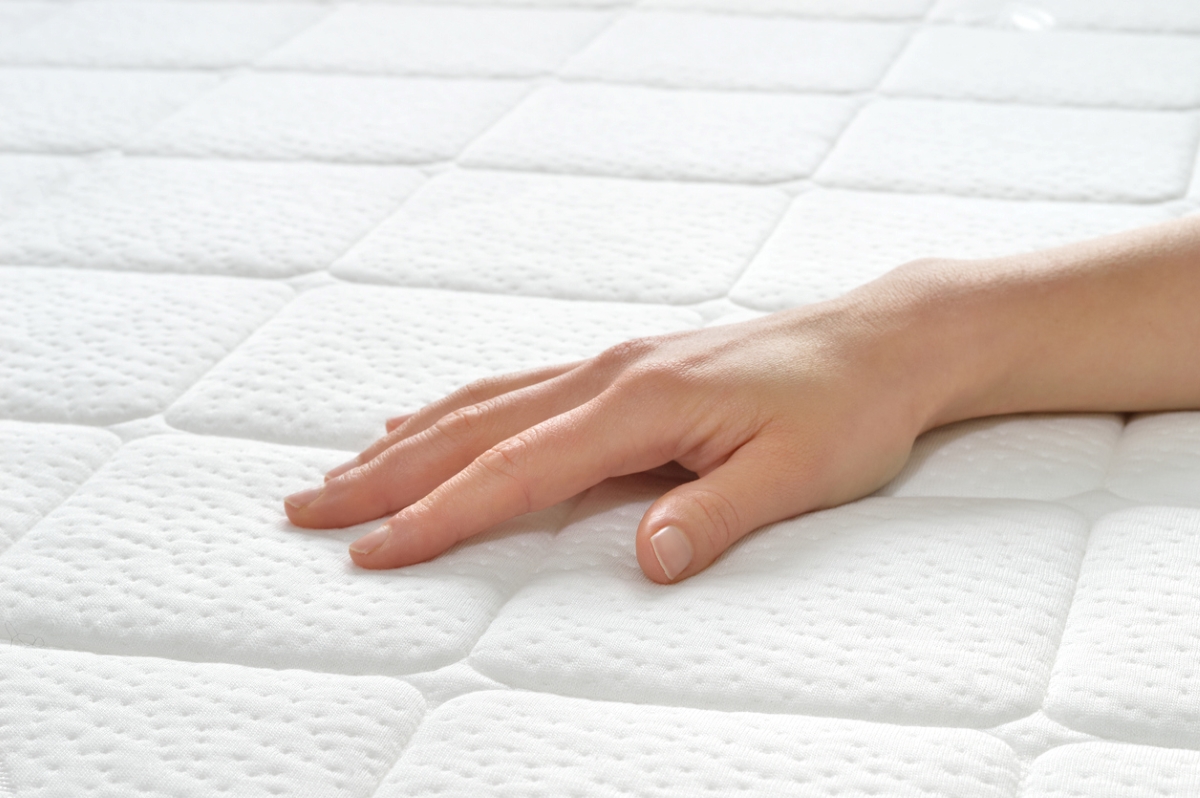

We may earn revenue from the products available on this page and participate in affiliate programs. Learn More ›
Memory foam mattresses have become the go-to construction for most of America’s bedding manufacturers due to memory’s foam’s unique cushioning and support properties. Originally developed by the National Aeronautics and Space Administration (NASA) to protect and cushion astronauts’ bodies as they hurtled into space, memory foam is now one of the most popular materials used for mattresses and mattress toppers.
Consumers have embraced memory foam because…memory foam embraces them. Memory foam gently and slowly conforms to the shape of the body, cradling and supporting backs, necks, knees, and other “pressure points” while you sleep. Memory foam bedding also minimizes motion transfer, so people sharing a bed don’t disturb other sleepers while shifting position. The best memory foam mattresses truly deliver on the promise of providing a better night’s sleep. Some shoppers prefer a cool gel memory foam mattress because of its cooling properties.
But for all of memory foam’s advantages, it does have a potential downside: Cleaning a memory foam mattress can be difficult. Memory foam tends to absorb moisture and takes a long time to dry, which can create a breeding ground for bacteria, mold, mildew, and odors. Stains–especially liquid-based stains like urine or sweat–can be stubborn and hard to remove, potentially voiding the warranty on your mattress. Whether your bed set includes a memory foam topper, memory foam mattress cover, or consists of a full-blown memory foam mattress, it is important to establish a regular cleaning and maintenance routine to keep your sleep surface clean and fresh. Following are some key techniques to help you learn how to clean a memory foam mattress.
RELATED: The 15 Best Places To Buy a Mattress
Tools & Materials
Bobvila.com may earn a commission from purchases made through these links.
Project Overview
Working Time: 30 to 90 minutes
Total Time: 24 to 48 hours
Skill Level: Beginner
Estimated Cost: $20 to $200
BEFORE YOU BEGIN
Addressing mattress stains and spills promptly is essential to maximizing the lifespan of your memory foam mattress. Stains actually can degrade and break down the cellular structure of the memory foam, causing it to disintegrate over time. That being said, there are differences in how you treat “wet” stains–urine, wine, coffee etc.–and how to approach other types of stains, including blood and food spills. Following are some tips and techniques on how to clean a memory foam mattress. In general, you should avoid using harsh cleansers on your memory foam mattress or topper, as these also will degrade the structure of the foam. Also, avoid over-saturating the foam with moisture: memory foam can take a long time to dry, and damp memory foam may lead to mold and mildew. Never use a steamer or carpet cleaner on memory foam, as both will cause over-saturation of the foam, making it nearly impossible to dry.
RELATED: 9 Ways You’re Ruining Your Mattress
STEP 1: Vacuum weekly, or whenever you change your sheets.

A regular weekly vacuum cleaning will make your sleep surface smell better and help minimize dust, dust mites, hair, pet dander and other debris that can collect on your mattress. Each week, when you strip your bed to change the sheets, use a hand-held vacuum with a brush attachment–also known as an upholstery brush– to go over the entire surface of the mattress. Be sure to go slow, to ensure that the brush attachment can dislodge any small particles. Use the vacuum’s crevice tool to get into the edges and around the piping where dust and hair accumulate.
STEP 2: Sprinkle with baking soda; let sit for up to 12 hours, and then vacuum.
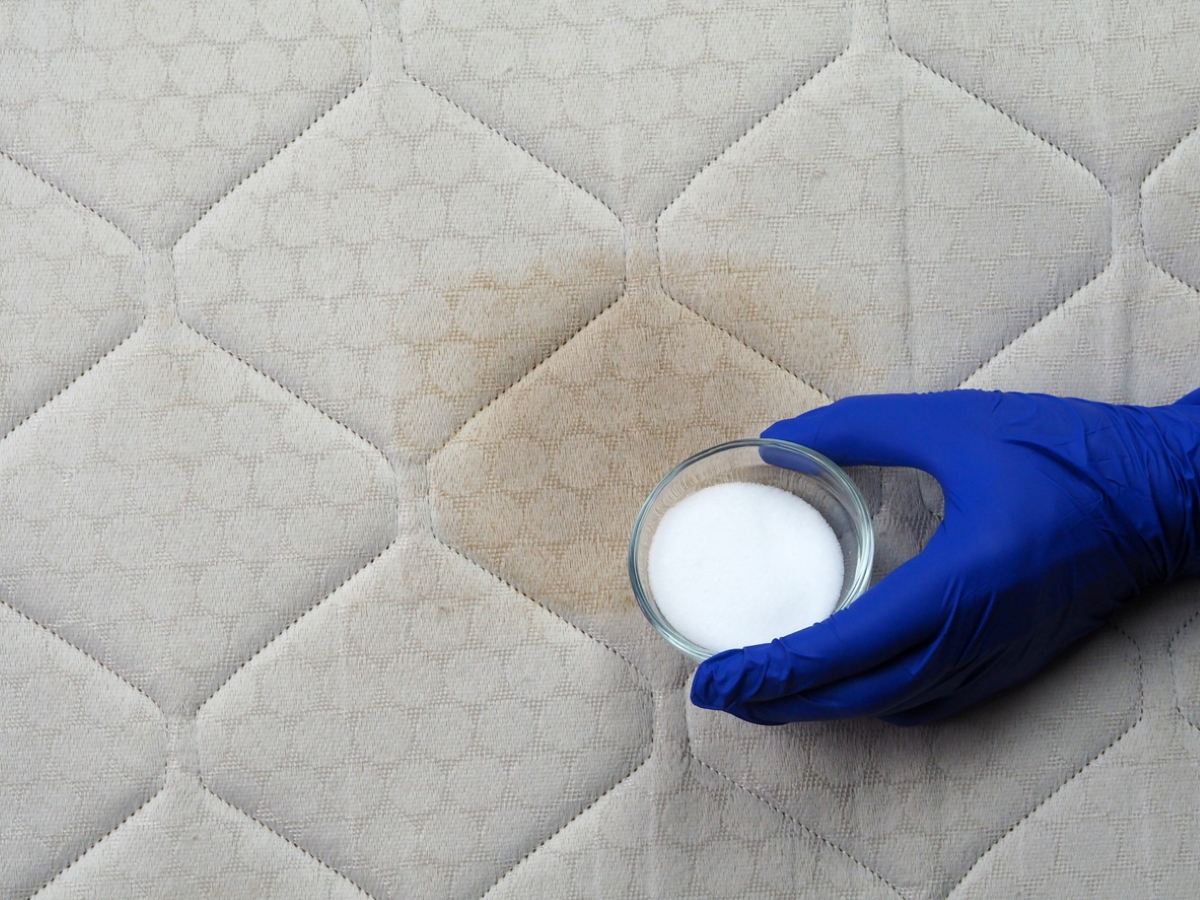
A regular sprinkle of baking soda across the top of your memory foam mattress will do wonders to minimize odors and freshen your entire bedroom environment. Every month or so, as you’re changing the sheets, sprinkle a liberal amount of baking soda across the mattress, applying enough to cover the mattress but not so much that the entire surface is white. (Think a light dusting of snow, rather than a blizzard!)
Leave the baking soda and mattress uncovered for up to 12 hours: the baking soda slowly will absorb odors and moisture that may be trapped in the very top layers of the memory foam. Once it is time to make the bed, vacuum thoroughly, using the same procedure as in step 1. Continue vacuuming until all the baking soda has been removed.
STEP 3: Blot–don’t rub–wet stains and spills promptly with a clean white towel.
It is far easier to get rid of wet stains when they are fresh, rather than after they have soaked thoroughly into the mattress. The most common wet stains are sweat, urine, and vomit. The first step is to blot and soak up as much of the liquid as possible with a clean, white kitchen towel (absorbent bar towels are ideal for this process). Note: don’t use colored towels, as the dye can come off on the memory foam, creating yet another stain.
Once you’ve blotted up the spill, lightly mist the area with plain water, and blot with another clean, dry towel. Repeat the process until the entire stain is gone. Leave the mattress uncovered and allow it to dry thoroughly; you can use a small fan or a hair dryer on the lowest setting to hasten drying time.
STEP 4: Use mild soap followed by plain water for set-in wet stains and blood.
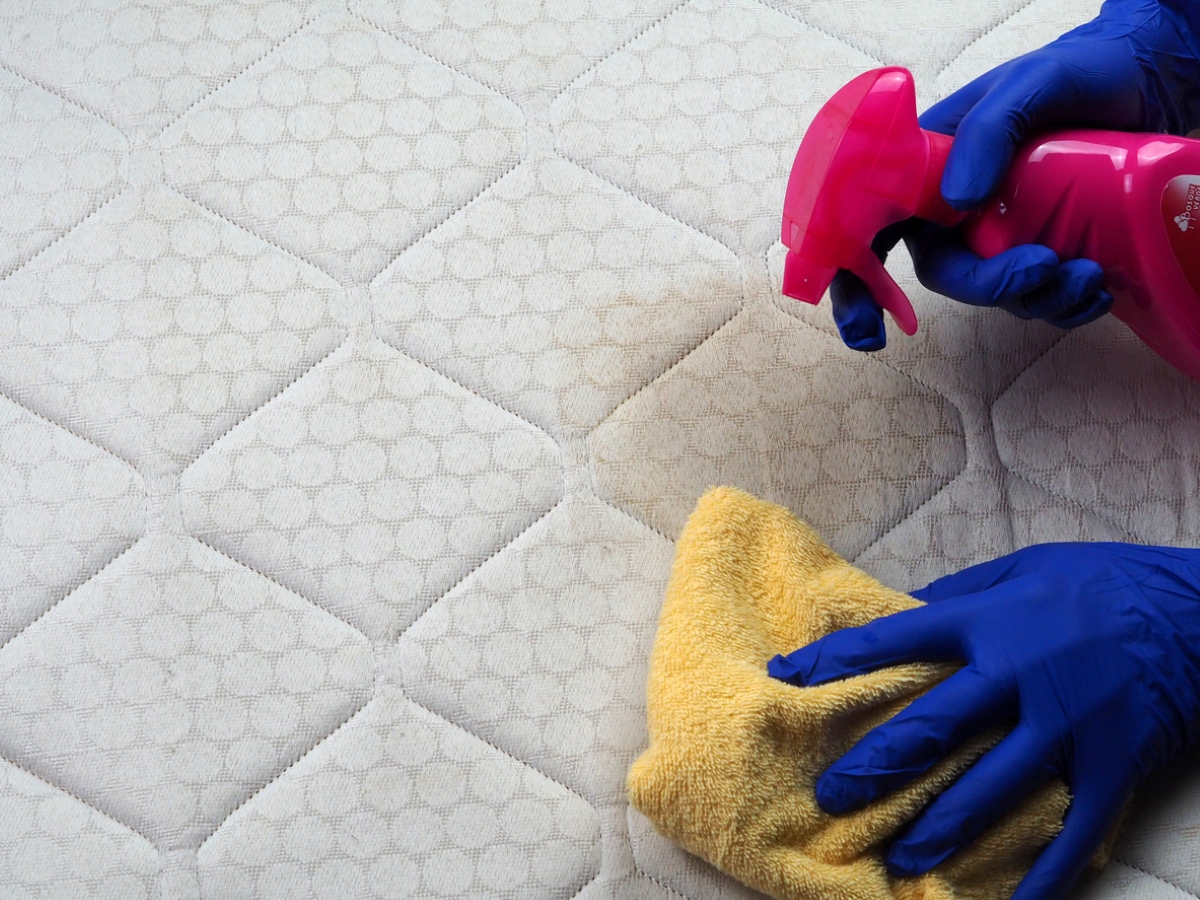
You may not always know about a spill before it has had a chance to “set.” Some of the most troublesome stains to remove are blood stains. For these types of stains, you may have to turn to something a bit stronger than plain water. Mix a few drops of mild dish soap into a spray bottle filled with water. Mist and blot the area as in step 3, and dry thoroughly. You may need to repeat this several times. Only use cold water on blood stains; hot water will set the stain and you may not ever be able to remove it.
For extremely tough, set-in stains, mix one cup of white vinegar with three tablespoons of baking soda and a few drops of mild dish soap in a spray bottle. Mist with the solution and blot the area with a clean towel until the stain is gone. You may need to rub lightly with an old toothbrush or very soft-bristled brush, but try to avoid this, as it may damage the foam. Remember to dry thoroughly.
STEP 5: Use mild laundry detergent to remove food and beverage stains.
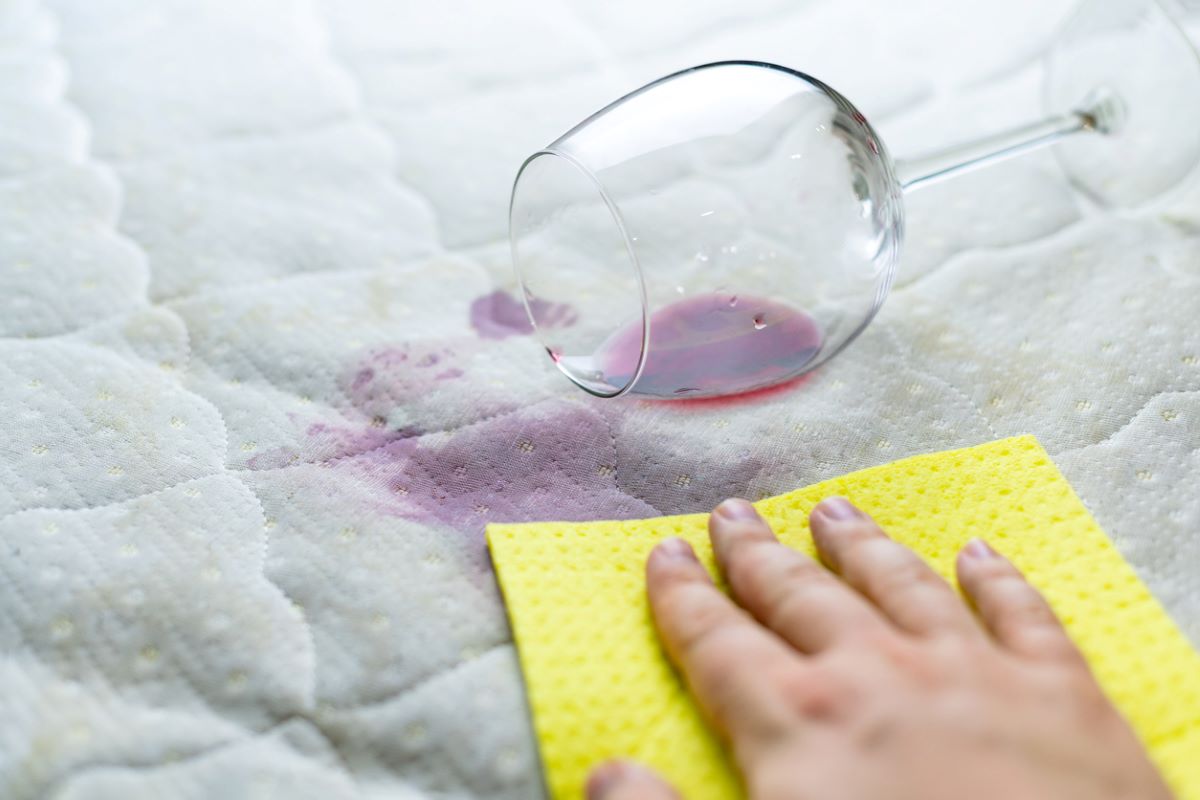
Coffee, wine, milk, juice, tomato sauce, cooking grease, chocolate, cereal, and candy are just some of the common food and beverage stains that can make their way onto your mattress…especially if you like to eat or drink in bed (which should be a no-no!) These common food and beverage spills respond best to mild laundry detergent mixed with vinegar and water. First, remove as much of the spill as possible with a clean white towel. Then, mix one part laundry detergent, one part vinegar, and 10 parts water in a spray bottle. Mist the area thoroughly and allow the solution to remain on the stain for 10 to 15 minutes. Blot with a clean wet towel, repeating as necessary until the entire stain is gone. Mist with plain water, and blot with a clean, dry towel, letting the foam dry completely.
RELATED: Solved! The Best Time to Buy a Mattress
Important Memory Foam Mattress Maintenance Tips
There are many different types of memory foam mattresses offered in a wide variety of constructions. The most common types include: traditional memory foam mattresses; open cell memory foam mattresses that are less dense than traditional foam; gel foam mattresses that include a layer of cushioning and cooling gel; mattresses that combine different types of foams, such as memory foam and latex, to create different levels of support; and hybrid mattresses that pair memory foam with traditional innerspring constructions.
Regardless of the specific construction of your mattress, a few tips and techniques will help keep your mattress in tip-top condition and maximize its comfort and lifespan.
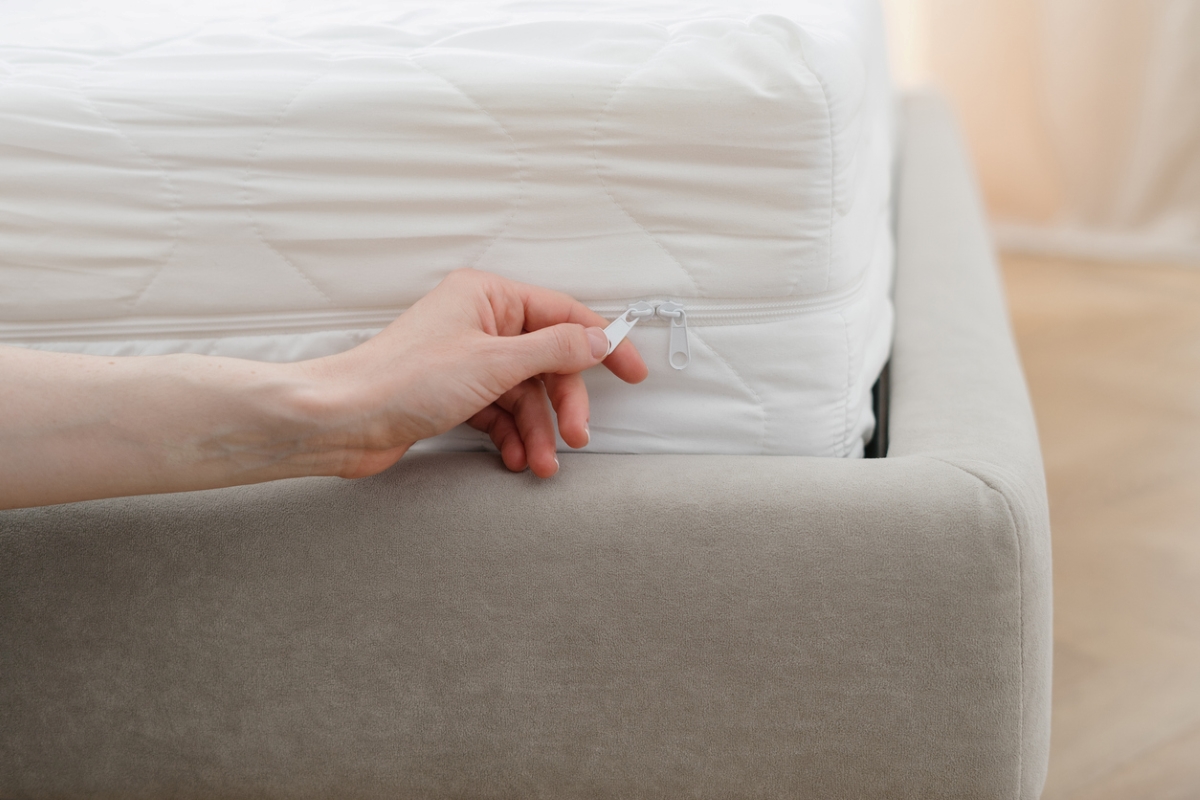
- Use a mattress protector to cover or encase your mattress. Today’s mattress protectors help repel spills, stains, and liquids. A good-quality mattress cover also will help prevent body oils, sweat, dead skin cells, and dust mites from soaking into your mattress.
- Institute a regular cleaning and maintenance routine, including regular vacuuming.
- Blot spills promptly with clean, absorbent towels.
- Treat stains as soon as they are discovered using the techniques outlined here.
- Don’t saturate your memory foam mattress with liquid.
- Avoid using harsh chemicals or cleansers.
- Don’t use a steamer or carpet cleaner to wash memory foam.
- Always make sure to dry your memory foam mattress thoroughly before re-making the bed.
- Don’t place memory foam outside or in direct sunlight, as this can cause oxidation, leading to yellowing and disintegration of the foam.
- Know when to say “when.” Sometimes, your old mattress just isn’t doing the job anymore, but it can be hard to know when you should replace your mattress. If the quality of your sleep deteriorates so that you wake up tired or sore; there are visible signs of wear and tear; or sagging or lumpy areas in your mattress, it is time to start shopping for a new mattress.
RELATED: 5 of the Best Cleaning Services in America, Vetted
Final Thoughts
Memory foam mattresses are extremely popular today due to a combination of cushy comfort and strong support. Memory foam cradles and “hugs” the sleeper’s body, and relieves pressure on aching joints, helping users achieve deeper, sounder sleep.
Maintaining a memory foam mattress or mattress topper with a regular cleaning routine can help you get the most for your money by maximizing the longevity of your bedding set. Weekly cleaning with a hand-held vacuum will get rid of dust and debris, while a sprinkling of baking soda can minimize odors. Always blot spills immediately with a clean white towel, and treat stains as soon as they are discovered. Adhering to a regular mattress cleaning routine will help ensure that your sleeping surface is always clean and fresh, ready for a good night’s rest.
FAQ About Cleaning Memory Foam Mattresses
Whether you have a king size memory foam mattress, or something smaller, these mattresses can be a bit tricky to clean, as the foam tends to absorb moisture and also takes a long time to dry. Stagnant, damp memory foam in turn can create an environment where bacteria, mold, and mildew thrive…and no one wants to sleep on that! Regular cleaning can help prevent odors, stains, and debris from shortening the lifespan of your memory foam mattress.
Q. How often should memory foam mattresses be cleaned?
Memory foam mattresses should be vacuumed weekly when sheets are changed, sprinkled with baking soda and vacuumed monthly or bi-monthly, and spills and stains should be blotted up and cleaned whenever they occur.
Q. Does memory foam get ruined when it gets wet?
Memory foam is not ruined by moisture, but it can take a very long time to dry. Avoid saturating a memory foam mattress or topper.
Q. Will a mattress protector work for my memory foam mattress?
You should use a mattress protector, mattress cover, or mattress encasement protector for every memory foam mattress.
Q. What can I clean my memory foam mattress with?
A light mist of plain water is sufficient to clean most spills; a sprinkling of baking soda can remove odors. Tougher stains can be removed with a combination of mild dish soap, white vinegar, hydrogen peroxide (with caution, as it can discolor fabric), or laundry detergent; the cleanser you use will depend upon the type of stain.
Q. What causes yellow stains on memory foam mattresses?
A slight yellowing or discoloration is a natural part of memory foam’s aging process, and should not be cause for alarm. Typically, memory foam turns yellow due to a process known as oxidation, caused by exposure to direct sunlight and/or UV light. Also, some of the chemicals used to make memory foam flame-retardant yellow with age. Yellowing does not affect the cushioning or support of a memory foam mattress.
Q. How do you get urine out of a memory foam mattress?
Blot up as much of the urine with a clean white towel, then mist the area lightly with plain water; repeat as often as necessary until the urine is gone. For set-in urine stains, mix a few drops of mild dish soap into a spray bottle filled with plain water. Mist and blot the area repeatedly. Allow the memory foam to dry thoroughly.
